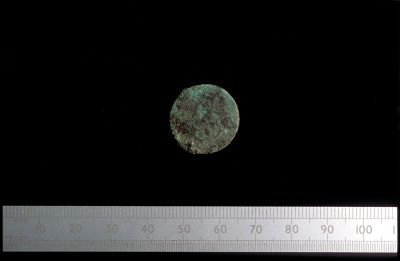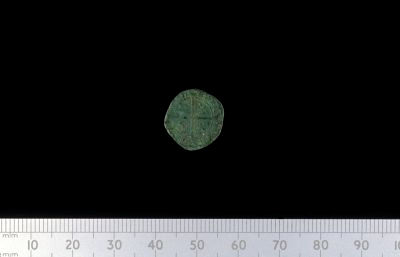
Despite the number of early 14th-century coin hoards which have been found in Aberdeen city centre, individual finds of English Edwardian silver pennies have been noticeably absent from archaeological sites in the area.
Four coins and a jetton have been invaluable in dating this site. A long cross penny of Henry III [1672] in a foundation trench for Structure 6 Room 4 (the south range building) gave a construction date in the 1250s or 1260s to as late as the 1280s. This could give a date for the construction of the building prior to the Carmelites purchasing this site or it could be one of the first buildings constructed by the Carmelites after 1273. A rare James I Scottish billon halfpenny [16] (dated 1406-37 and minted in Edinburgh) found in AAB, the foundation trench for the east wall of the West Range, gave a construction date in the early 15th century. A Nuremberg jetton [2289] (1480-1550) was found in the West Range demolition material. Jettons were found at St Frideswide's Augustinian priory in Oxford and were probably used as tokens for gaming (Blair 1990).
Residual coins include cut halfpennies from silver short cross pennies of John [1674] and one of Henry III [1673], both lost as late as 1250, which were found in burial soils inside the stone church. Two Edwardian pennies and one from an earlier reign (Henry III) were excavated during the 1994 season.

By the beginning of the 15th century native Scottish coins had largely replaced 'imported' English money in Scotland and the three Scottish pieces from this site are typical of the low-denomination pieces one would expect from casual losses. A coin notable for its rarity was a late-issue (c.1483) billon plack of James III [17]. Another coin of this group is a much commoner (but better preserved) penny of James IV (c.1497 [18]) [Photo 0254]. Both coins were minted in Edinburgh.

A Scottish copper bodle (Charles II, 1677-9, [19]) [Photo 0268] found in demolition material associated with the West Range, suggests activity in this area in the late 17th century.
Coin weight
A small rectangular object [1675] with a low-relief design of a three-towered castle on the upper surface appears to be a coin weight, and if so it may be a very rare specimen of such an item manufactured in Scotland for use with Scottish coinage. The three-towered castle would represent Edinburgh. The device belongs to the coat of arms of that city and has been utilised since 1485 as a gold and silver hallmark of the Edinburgh assay office. This weight is unusual in a number of respects, bearing no indication of the appearance or value of the coin it was intended to weigh, nor any design on the reverse, where early coin weights often bore accessory marks, to indicate official acceptance of their mass. These factors, and its mediocre workmanship, may indicate that it was not produced at the official mint. Independent manufacturers are known to have produced unofficial or counterfeit weights in other countries, and these often incorporated mistakes in both mass and design. Attempts to identify an issue of coinage in respect of which this weight could have been made produce only one type of gold or silver coins of the appropriate date. The gold 'hat pieces' of James VI's 6th coinage (1591-3) had a theoretical mass of 69.8 grains. The coin weight is marginally lighter at 68.7 grains, but a variation such as this could be accounted for by effects of wear and corrosion.
Grierson (1988) has suggested that this coin weight may not be of Scottish origin at all, but could have been made in the Low Countries for use in connection with a gold coin, known as castellano d'oro, issued by Henry IV of Castile and Leon (1454-74).

A splendidly mixed group of modern pieces completes the numismatic finds from this site. These comprise a 17th-century Scottish coin [19], a 19th-century British counterfeit copy, an advertising token [21] [Photo 0270] and a royal commemorative medal [22]. Individually, these require no comment but their presence suggest continuing activity in the area almost up to the present day.
Internet Archaeology is an open access journal based in the Department of Archaeology, University of York. Except where otherwise noted, content from this work may be used under the terms of the Creative Commons Attribution 3.0 (CC BY) Unported licence, which permits unrestricted use, distribution, and reproduction in any medium, provided that attribution to the author(s), the title of the work, the Internet Archaeology journal and the relevant URL/DOI are given.
Terms and Conditions | Legal Statements | Privacy Policy | Cookies Policy | Citing Internet Archaeology
Internet Archaeology content is preserved for the long term with the Archaeology Data Service. Help sustain and support open access publication by donating to our Open Access Archaeology Fund.